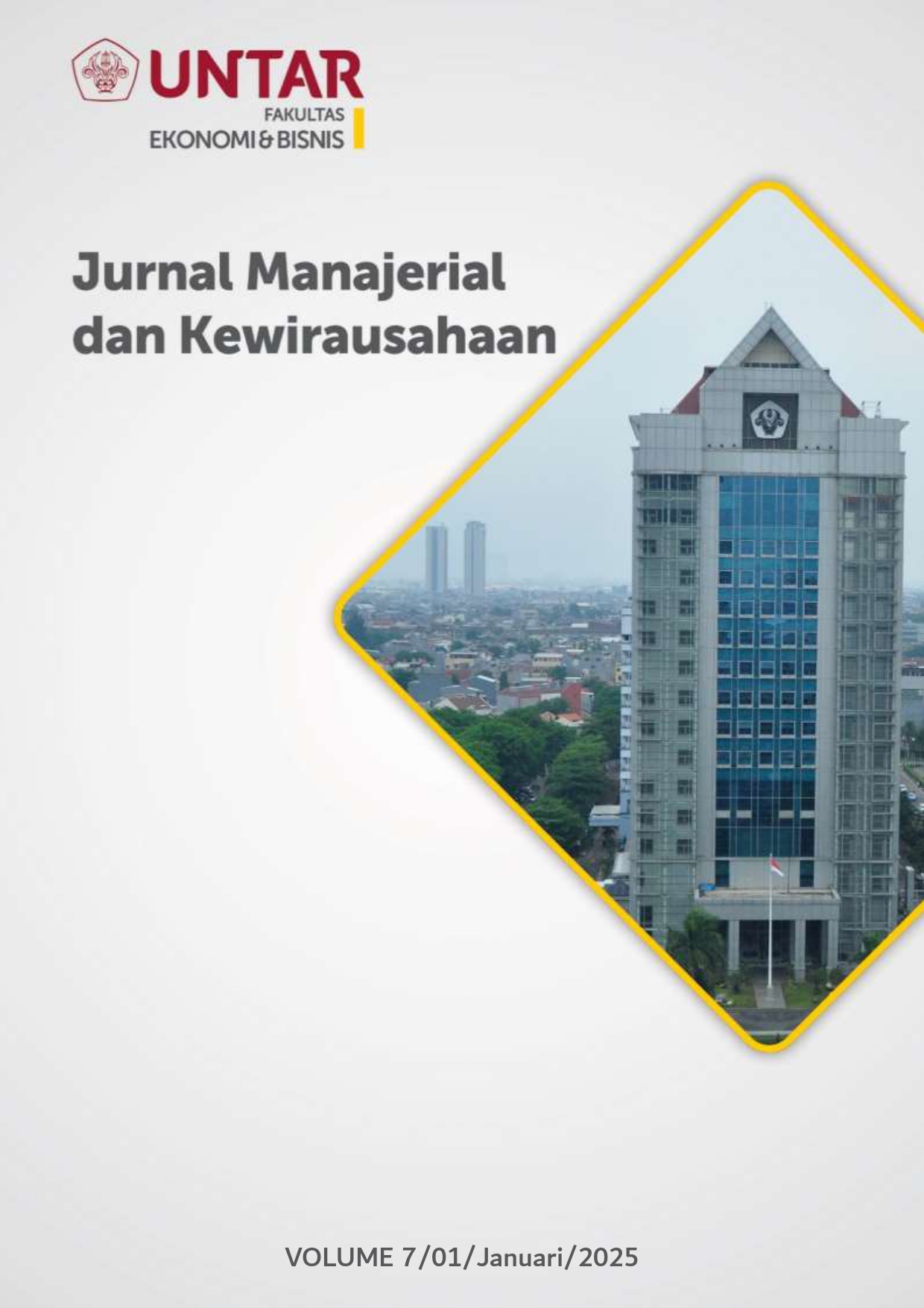Implementasi Keuangan Hijau terhadap Kinerja Perbankan di Negara ASEAN
Main Article Content
Abstract
This research was conducted to review whether green bonds have a better level of risk and return than conventional bonds and to find out whether the issuance of green bonds and macroeconomic variables can influence bank performance in ASEAN countries. This research also tests whether risk management can play a mediating role in the relationship between bonds (green bonds and conventional bonds) and bank performance. This research is descriptive research conducted using quantitative methods. The data in this research was taken from financial reports of banking companies that were open to the public in ASEAN countries in 2019-2022. Data collection was carried out using the judgment sampling method. The data in this study were analyzed using SmartPLS 4.1.0.5. The results of this study show that green bonds have a better level of risk and return than green bonds. Green bond issuance has a negative, but not significant relationship with bank performance. Macroeconomic variables have a positive and significant influence on bank performance. Risk management has a positive and significant influence on bank performance. Risk management can mediate the relationship between bonds (green bonds and conventional bonds) and bank performance. This research found that the issuance of green bonds can empirically increase the diversification of banking company portfolios in ASEAN countries even though it does not have an influence on bank performance.
Article Details

This work is licensed under a Creative Commons Attribution-NonCommercial-ShareAlike 4.0 International License.
This work is licensed under a Jurnal Muara Ilmu Ekonomi dan Bisnis Creative Commons Attribution-ShareAlike 4.0 International License.,/p>
References
Ahmed, A. (2018). Interest Rate and Financial Performance of Banks in Pakistan. International Journal of Applied Economics, Finance and Accounting, 2(1), 1-7. https://doi.org/10.33094/8.2017.2018.21.1.7
Alsharif, M. (2023). Interest Rate, Foreign Exchange and Stock Performance in a Dual Banking Industry: Evidence from Saudi Arabia. Journal of Money and Business, 3(1), 60-73. https://doi.org/10.1108/jmb-10-2022-0052
Antoniuk, Y. & Leirvik, T. (2021). Climate Transition Risk and the Impact on Green Bonds. Journal of Risk and Financial Management, 14(12), 1-19. https://doi.org/10.3390/jrfm14120597
Asian Development Bank dan Global Green Growth Institute. (2022). Survey on Green Bonds and Sustainable Finance in ASEAN Insights on the Perspectives of Institutional Investors and Underwriters.
Batayneh, K., Al Salamat, W., & Momani, M. Q. M. (2021). The Impact of Inflation on the Financial Sector Development: Empirical Evidence from Jordan. Cogent Economics and Finance, 9(1). https://doi.org/10.1080/23322039.2021.1970869
Baulkaran, V. (2019). Stock Market Reaction to Green Bond Issuance. Journal of Asset Management, 20(5), 331–340. https://doi.org/10.1057/s41260-018-00105-1
C. R., S., Mapharing, M., Mphoeng, M., & Dzimiri, M. (2019). Impact of Financial Risk Management Practices on Financial Performance: Evidence from Commercial Banks in Botswana. Applied Finance and Accounting, 6(1), 25. https://doi.org/10.11114/afa.v6i1.4650
Cicchiello, A. F., Cotugno, M., Monferrà, S., & Perdichizzi, S. (2022). Credit Spreads in the European Green Bond Market: A Daily analysis of the COVID-19 Pandemic Impact. Journal of International Financial Management and Accounting, 33(3), 383–411. https://doi.org/10.1111/jifm.12150
Desalegn, G., & Tangl, A. (2022). Enhancing Green Finance for Inclusive Green Growth: A Systematic Approach. In Sustainability (Switzerland) (Vol. 14, Issue 12). MDPI. https://doi.org/10.3390/su14127416
Fang, J., Lau, C. K. M., Lu, Z., Tan, Y., & Zhang, H. (2019). Bank Performance in China: A Perspective from Bank efficiency, Risk-taking and Market Competition. Pacific Basin Finance Journal, 56, 290–309. https://doi.org/10.1016/j.pacfin.2019.06.011
Garcia, M. T. M., & Trindade, M. J. (2019). Determinants of Banks’ Profitability in Angola. African Journal of Economic and Management Studies, 10(1), 116–128. https://doi.org/10.1108/AJEMS-06-2018-0161
Hair, J. F., Hult, G. T. M., Ringle, C. M., & Sarstedt, M. (2022). A Primer On Partial Least Squares Structural Equation Modeling (PLS-SEM) Third Edition (Third). SAGE.
Hossain, Md. A., Rahman, Md. M., Hossain, Md. S., & Karim, Md. R. (2020). The Effects of Green Banking Practices on Financial Performance of Listed Banking Companies in Bangladesh. Canadian Journal of Business and Information Studies, 120–128. https://doi.org/10.34104/cjbis.020.01200128
Hunjra, A. I., Mehmood, A., Nguyen, H. P., & Tayachi, T. (2022). Do Firm-specific Risks Affect Bank Performance? International Journal of Emerging Markets, 17(3), 664–682. https://doi.org/10.1108/IJOEM-04-2020-0329
Kakar, S. K., Ali, J., Bilal, M., Tahira, Y., Tahir, M., Bahadar, N., Bukhari, H., Ullah, S., & Aziz, T. (2021). Corporate Governance, Risk Management, and Bank Performance: Does Type of Ownership Matter? Journal of Financial Risk Management, 10(03), 342–366. https://doi.org/10.4236/jfrm.2021.103020
Lebelle, M., Lajili Jarjir, S., & Sassi, S. (2020). Corporate Green Bond Issuances: An International Evidence. Journal of Risk and Financial Management, 13(2). https://doi.org/10.3390/jrfm13020025
Lelissa, T. B. (2019). Panel Data Analysis on the Impact of Industry and Macroeconomic Factors on Bank Performance: The Case of Ethiopia. European Journal of Business and Management, 11(10). https://doi.org/10.7176/EJBM
Liu, C., & Wu, S. S. (2023). Green Finance, Sustainability Disclosure and Economic Implications. Fulbright Review of Economics and Policy, 3(1), 1–24. https://doi.org/10.1108/frep-03-2022-0021
Liu, N., Liu, C., Xia, Y., Ren, Y., & Liang, J. (2020). Examining the Coordination between Green Finance and Green Economy Aiming for Sustainable Development: A Case Study of China. Sustainability (Switzerland), 12(9). https://doi.org/10.3390/su12093717
Nabil, M. (2023). The Impact of Green Bonds on Banking Sector Performance: A Comparative Study on Developed and Emerging Markets. Journal of Applied Finance & Banking, 67–85. https://doi.org/10.47260/jafb/1334
O’Connell, M. (2023). Bank-specific, Industry-specific and Macroeconomic Determinants of Bank Profitability: Evidence from the UK. Studies in Economics and Finance, 40(1), 155–174. https://doi.org/10.1108/SEF-10-2021-0413
Tsoukala, A. (Katerina), & Tsiotas, G. (2021). Assessing Green Bond Risk: An Empirical Investigation. Green Finance, 3(2), 222–252. https://doi.org/10.3934/GF.2021012
Wang, G., Li, S., & Yang, L. (2022). Research on the Pathway of Green Financial System to Implement the Realization of China’s Carbon Neutrality Target. International Journal of Environmental Research and Public Health, 19(4). https://doi.org/10.3390/ijerph19042451
Wang, X., & Wang, S. (2020). The Impact of Green Finance on Inclusive Economic Growth—Empirical Analysis Based on Spatial Panel. Open Journal of Business and Management, 08(05), 2093–2112. https://doi.org/10.4236/ojbm.2020.85128



